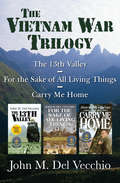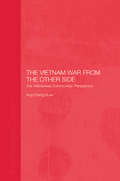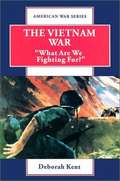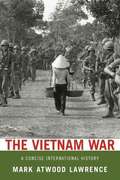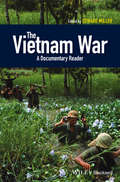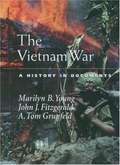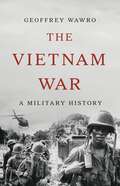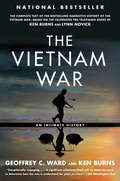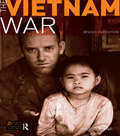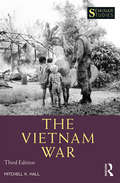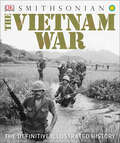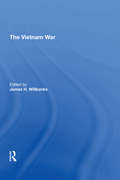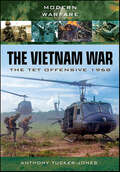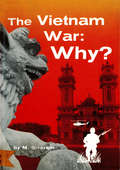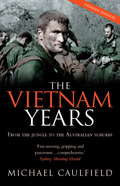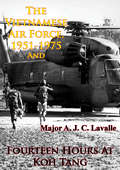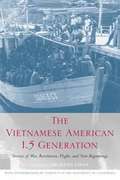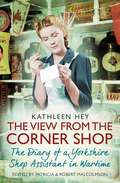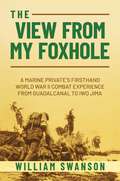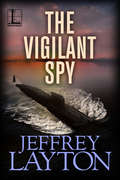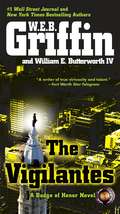- Table View
- List View
The Vietnam War Trilogy
by John M. Del VecchioThree classic novels by John M. Del Vecchio about Vietnam, Cambodia, and the aftermath of war A classic combat novel and National Book Award finalist, The 13th Valley follows the terrifying Vietnam combat experiences of James Chelini, a telephone-systems installer who finds himself an infantryman in the North Vietnamese Army-infested mountains of the I Corps Tactical Zone. Spiraling deeper and deeper into a world of conflict and darkness, this harrowing account plunges Chelini into jungle warfare and traces his evolution from semi-pacifist to all-out, combat-crazed soldier. The seminal novel on the Vietnam experience, The 13th Valley is a classic that illuminates the war in Southeast Asia like no other book. Some reviewers have called For the Sake of All Living Things the most terrifying book they have ever read. This saga follows a rural Cambodian family--father Chhoun; his beautiful daughter, Vathana; and his young son, Samnang, who becomes the Khmer Rouge yothea Met Nang--from the mid-sixties through the escalation of the civil war, into the horrors of the holocaust, and finally to the country's quest for rebirth. Documenting their story is American Special Forces Captain John Sullivan who served with the Military Equipment Delivery Team, and who has fallen in love with Vathana. Carry Me Home brings the troops back to America--a nation confused and divided by the wars in Southeast Asia. In this poignant epic, Del Vecchio transports a group of soldiers to their final battlefield: the home front. High Meadow Farm, in the fertile hill country of central Pennsylvania, becomes their salvation. In Vietnam they had been brothers in arms. Now, in the face of personal tragedy and bureaucratic deception, they create an even deeper allegiance--one of the spirit and of the land. This is the remarkable story of the veterans' struggle to find one another and themselves. In its scope, breadth, and brilliance, Carry Me Home is much more than a novel about Vietnam vets; it is a testament to history and hope, to hometowns and homecomings, to love and loss, and to faith and family. It is an inspiring and unforgettable novel about America itself.
The Vietnam War from the Other Side
by Cheng Guan AngExisting studies of the Vietnam War have been written mostly from an American perspective, using western sources, and viewing the conflict through western eyes. This book, based on extensive original research, including Vietnamese, Chinese and former Soviet sources, presents a history of the war from the perspective of the Vietnamese communists. It charts relations with Moscow and Beijing, showing how the involvement of the two major communist powers changed over time, and how the Vietnamese, despite their huge dependence on the Chinese and the Soviets, were most definitely in charge of their own decision making. Overall, it provides an important corrective to the many one-sided studies of the war, and presents a very interesting new perspective.
The Vietnam War: "What Are We Fighting For?"
by Deborah KentFrom the book's foreword: "The United States was directly involved in the Vietnam War for twelve years, from 1961 to 1973. But for the Vietnamese, the years of American involvement were only one chapter in a far longer struggle. It began as a fight for independence and ended in a bitter civil war that tore the country to pieces". This book provides young adults with an accessible overview of the Vietnam War, and it explores the causes, course, and consequences of the Vietnam War. This book is part of the American War Series.
The Vietnam War: A Concise International History
by Mark Atwood LawrenceThe Vietnam War remains a topic of extraordinary interest, not least because of striking parallels between that conflict and more recent fighting in the Middle East. InThe Vietnam War, Mark Atwood Lawrence draws upon the latest research in archives around the world to offer readers a superb account of a key moment in U.S. as well as global history. <p><p> While focusing on American involvement between 1965 and 1975, Lawrence offers an unprecedentedly complete picture of all sides of the war, notably by examining the motives that drove the Vietnamese communists and their foreign allies. Moreover, the book carefully considers both the long- and short-term origins of the war. Lawrence examines the rise of Vietnamese communism in the early twentieth century and reveals how Cold War anxieties of the 1940s and 1950s set the United States on the road to intervention. Of course, the heart of the book covers the "American war," ranging from the overthrow of South Vietnamese President Ngo Dinh Diem to the impact of the Tet Offensive on American public opinion, Lyndon Johnson's withdrawal from the 1968 presidential race, Richard Nixon's expansion of the war into Cambodia and Laos, and the problematic peace agreement of 1973, which ended American military involvement. Finally, the book explores the complex aftermath of the war--its enduring legacy in American books, film, and political debate, as well as Vietnam's struggles with severe social and economic problems. <p> A compact and authoritative primer on an intensely relevant topic, this well-researched and engaging volume offers an invaluable overview of the Vietnam War.
The Vietnam War: A Documentary Reader (Uncovering the Past: Documentary Readers in American History)
by Edward MillerThe Vietnam War is an outstanding collection of primary documents related to America’s conflict in Vietnam which includes a balance of original American and Vietnamese perspectives, providing a uniquely varied range of insights into both American and Vietnamese experiences. Includes substantial non-American content, including many original English translations of Vietnamese-authored texts which showcase the diversity and complexity of Vietnamese experiences during the war Contains original American documents germane to the continuing debates about the causes, consequences and morality of the US intervention Incorporates personal histories of individual Americans and Vietnamese Introductory headnotes place each document in context Features a range of non-textual documents, including iconic photographs and political cartoons
The Vietnam War: A History in Documents
by Marilyn B. Young John J. Fitzgerald A. Tom GrunfeldThe Vietnam War tells the story of one of the most divisive episodes in modern American history through primary sources, ranging from government documents, news reports, speeches, popular songs to memoirs, writings by Vietnam veterans (including coauthor John Fitzgerald), and poetry by Vietnamese and Americans on matching themes. The book begins in the 19th century when Vietnam became a French colony, and traces the insidious route by which the United States became involved in a war on the other side of the world.
The Vietnam War: A Military History
by Geoffrey WawroThe first comprehensive military history of the war in Vietnam The Vietnam War cast a shadow over the American psyche from the moment it began. In its time it sparked budget deficits, campus protests, and an erosion of US influence around the world. Long after the last helicopter evacuated Saigon, Americans have continued to battle over whether it was ever a winnable war. Based on thousands of pages of military, diplomatic, and intelligence documents, Geoffrey Wawro&’s The Vietnam War offers a definitive account of a war of choice that was doomed from its inception. In devastating detail, Wawro narrates campaigns where US troops struggled even to find the enemy in the South Vietnamese wilderness, let alone kill sufficient numbers to turn the tide in their favor. Yet the war dragged on, prolonged by presidents and military leaders who feared the political consequences of accepting defeat. In the end, no number of young lives lost or bombs dropped could prevent America&’s ally, the corrupt South Vietnamese regime, from collapsing the moment US troops retreated. Broad, definitive, and illuminating, The Vietnam War offers an unsettling, resonant story of the limitations of American power.
The Vietnam War: A MyReportLinks.com Book
by Carl R. GreenThis book presents an overview of the conflict between North and South Vietnam, beginning with events leading up to the war, as well as accounts of the battles, key participants, and a summation of the war's legacy.
The Vietnam War: An Intimate History
by Geoffrey C. Ward Ken BurnsFrom the award-winning historian and filmmakers of The Civil War, Baseball, The War, The Roosevelts, and others: a vivid, uniquely powerful history of the conflict that tore America apart--the companion volume to the major, multipart PBS film to be aired in September 2017.More than forty years after it ended, the Vietnam War continues to haunt our country. We still argue over why we were there, whether we could have won, and who was right and wrong in their response to the conflict. When the war divided the country, it created deep political fault lines that continue to divide us today. Now, continuing in the tradition of their critically acclaimed collaborations, the authors draw on dozens and dozens of interviews in America and Vietnam to give us the perspectives of people involved at all levels of the war: U.S. and Vietnamese soldiers and their families, high-level officials in America and Vietnam, antiwar protestors, POWs, and many more. The book plunges us into the chaos and intensity of combat, even as it explains the rationale that got us into Vietnam and kept us there for so many years. Rather than taking sides, the book seeks to understand why the war happened the way it did, and to clarify its complicated legacy. Beautifully written and richly illustrated, this is a tour de force that is certain to launch a new national conversation.
The Vietnam War: Revised 2nd Edition
by Mitchell K. HallThe Vietnam War examines the conflict from its origins through to 1975 and North Vietnam’s victory. This new revised edition is completely up-to-date with current academic debates and includes new source material. Mitchell Hall explores all the key elements of the conflict, including: · US motivations for entering the war and the military strategies employed · The role of the media · The rise of domestic opposition · The war’s impact in the US and Vietnam. Mitchell Hall provides numerous insights into the political decisions of the Vietnamese communists, and Vietnam’s relations with other major powers, particularly China and the Soviet Union. The main text is supported by a comprehensive documents section, and a range of study tools, including a Chronology of events, Who's Who, a Glossary of terms and a Further Reading section. Concise yet thorough, the book provides students with an accessible and stimulating introduction to the war.
The Vietnam War: Revised 2nd Edition (Seminar Studies)
by Mitchell HallThe Vietnam War examines this conflict from its origins up until North Vietnam’s victory in 1975. Historian Mitchell K. Hall’s lucid account is an ideal introduction to the key debates surrounding a war that remains controversial and disputed in American scholarship and collective memory. The new edition has been fully updated and expanded to include additional material on the preceding French Indochina War, the American antiwar movement, North Vietnamese perspectives and motivations, and the postwar scholarly debate. The text is supported by a documents section and a wide range of study tools, including a timeline of events, glossaries of key figures and terms, and a rich "further reading" section accompanied by a new bibliographical essay. Concise yet comprehensive, The Vietnam War remains the most accessible and stimulating introduction to this crucial 20th-century conflict.
The Vietnam War: The Definitive Illustrated History
by DKThe definitive telling of one of the longest and most controversial wars in US history.Delve into the compelling history and impact of the Vietnam War in reverting detail. This authoritative visual guide unpacks accounts of struggle, sacrifice, and bravery, making this a perfect read for any military history enthusiast.Inside the pages of this retelling of America's bloodiest conflict, you'll discover:- A vivid, moving, and informative read written in an engaging style.- A clear and compelling account of the conflict, in short, self-contained events from the Battle of Ia Drang to the Tet Offensive and The Khmer Rouge.- Biography pages highlight major military and political figures such as Henry Kissinger, President Nixon, General Thieu, and Ho Chi Minh.- Features on everyday life in the war offering additional context.- Stunning image double page features display weapons, spy gear, and other equipment that defined the war.- Maps and feature boxes provide additional information on significant events during the conflict.Created in association with the Smithsonian Institution, this history book for adults is an authoritative history of both the first televised war and its lasting impact through the lenses of both sides of the conflict. The Vietnam War explores all aspects of the conflict and the wider political landscape using compelling text, maps, and archive photography of collections of weapons, aircraft, and armored vehicles.The military techniques and conduct employed against the inferior technologies of the Viet Cong remain controversial and intriguing to date. Eyewitness accounts and iconic photographs bring events to life - from the background of the conflict to the incidents that drew America into Vietnam, the chronological event
The Vietnam War: The Definitive Illustrated History (DK Definitive Visual Histories)
by DKThe definitive telling of one of the longest and most controversial wars in US history.Delve into the compelling history and impact of the Vietnam War in reverting detail. This authoritative visual guide unpacks accounts of struggle, sacrifice, and bravery, making this a perfect read for any military history enthusiast.Inside the pages of this retelling of America's bloodiest conflict, you'll discover:- A vivid, moving, and informative read written in an engaging style.- A clear and compelling account of the conflict, in short, self-contained events from the Battle of Ia Drang to the Tet Offensive and The Khmer Rouge.- Biography pages highlight major military and political figures such as Henry Kissinger, President Nixon, General Thieu, and Ho Chi Minh.- Features on everyday life in the war offering additional context.- Stunning image double page features display weapons, spy gear, and other equipment that defined the war.- Maps and feature boxes provide additional information on significant events during the conflict.Created in association with the Smithsonian Institution, this history book for adults is an authoritative history of both the first televised war and its lasting impact through the lenses of both sides of the conflict. The Vietnam War explores all aspects of the conflict and the wider political landscape using compelling text, maps, and archive photography of collections of weapons, aircraft, and armored vehicles.The military techniques and conduct employed against the inferior technologies of the Viet Cong remain controversial and intriguing to date. Eyewitness accounts and iconic photographs bring events to life - from the background of the conflict to the incidents that drew America into Vietnam, the chronological event
The Vietnam War: The Essential Reference Guide (The\international Library Of Essays On Military History)
by James H. WillbanksThe Vietnam War remains one of the most contentious events in American history. This book is a collection of essays that seeks to examine the current state of scholarship on the war and its aftermath. It is divided into five sections which address American presidents and the war, the conduct of the war in the field, the impact of the Tet Offensive, the meaning of the war and its lasting legacies. The purpose of the collection is to present the most recent contributions to the continuing academic and scholarly dialogue about one of the most momentous historical events of the twentieth century.
The Vietnam War: The Tet Offensive, 1968 (Modern Warfare)
by Anthony Tucker-JonesThis Vietnam War history examines the grueling Tet Offensive and America&’s struggle against the Viet Cong with more than 180 wartime photographs. On January, 30th, 1968, the North Vietnamese communists launched a coordinated surprise attack across South Vietnam against the South Vietnamese and American armies. Superior firepower eventually crushed the offensive, but it proved to be a major moral victory for the communists, and a turning point in the Vietnam War. In this photographic history, Anthony Tucker-Jones tells the story of Tet through both color and black and white images showing all sides of the conflict. The result is a vivid reassessment of this defining moment in the bitter campaign against communism in South-East Asia. The images show the conditions, the nature of the fighting, and the equipment and the weaponry used—with special focus on the battles for Hue, Khe Sanh, and Saigon. They show the impact of combat on civilian populations as their communities became battlegrounds. And they illustrate why the assault caused many at home across the US to lose faith in America&’s commitment to the South.
The Vietnam War: Why?
by M. Sivaram"In Vietnam, the newsman is reporting a strange, baffling, frontless war-and an even stranger, more baffling, faceless political scene" writes M. Sivaram. In a factual, objective, straight-from-the-shoulder report he analyzes one of the most frustrating wars in history-and answers the question "Why?"The author, an Indian journalist who has covered such world trouble-spots as Korea, Suez, Malaya, and Laos, found Vietnam his most challenging assignment since the war. He describes the rise to power of North Vietnam's Ho Chih Minh-the most important, yet least known, war leader. He sketches the history of Vietnam from its earliest days, through its years as a French colony to today. He traces the history of the Diem family, its period of almost unlimited power, and its sudden fall. He takes his readers through the bewildering maze of coups and counter-coups which have devilled the government of South Vietnam and he shows the country-people of South Vietnam living in the constant shadow of war and death.This report on Vietnam is a clear, balanced and vivid picture of a country at war with itself, and of two rival ideologies-capitalism and communism-fighting for control in a struggle that could well decide the future of all Asia.
The Vietnam War: Why?
by M. Sivaram"In Vietnam, the newsman is reporting a strange, baffling, frontless war-and an even stranger, more baffling, faceless political scene" writes M. Sivaram. In a factual, objective, straight-from-the-shoulder report he analyzes one of the most frustrating wars in history-and answers the question "Why?"The author, an Indian journalist who has covered such world trouble-spots as Korea, Suez, Malaya, and Laos, found Vietnam his most challenging assignment since the war. He describes the rise to power of North Vietnam's Ho Chih Minh-the most important, yet least known, war leader. He sketches the history of Vietnam from its earliest days, through its years as a French colony to today. He traces the history of the Diem family, its period of almost unlimited power, and its sudden fall. He takes his readers through the bewildering maze of coups and counter-coups which have devilled the government of South Vietnam and he shows the country-people of South Vietnam living in the constant shadow of war and death.This report on Vietnam is a clear, balanced and vivid picture of a country at war with itself, and of two rival ideologies-capitalism and communism-fighting for control in a struggle that could well decide the future of all Asia.
The Vietnam Years: From the Jungle to the Australian Suburbs
by Michael CaulfieldThe Vietnam War was the longest and most divisive war in our history. Almost 60,000 Australians served and more than 500 were killed. At home, thousands protested against the war and conscription and hundreds were sent to jail. THE VIETNAM YEARS is the story of both sides of that war, from the vicious fighting of the jungle patroles and the bravery shown by so many Australians at the famous Battle of Long Tan, to families back home, ripped apart by confusion and anger. From Vung Tau to Nui Dat, from Bankstown to Broadmeadows, this is a book about Australians and for Australians.
The Vietnamese Air Force, 1951-1975 — An Analysis Of Its Role In Combat And Fourteen Hours At Koh Tang [Illustrated Edition] (USAF Southeast Asia Monograph Series #3)
by Major A. J. C. LavalleIllustrated with over 30 maps, diagrams and photosAs the final days of Vietnam unfolded, the question was raised, "What happened to the Vietnamese Air Force (VNAF)?" This monograph addresses that question in considerable detail. In order to sift out the story, three periods in the life of VNAF were selected-the Tet offensive of 1968, the Easter offensive of 1972, and lastly the March offensive of 1975. By examining each of these time periods, the factors at work in each period could be isolated so as to determine the performance of the VNAF.The role of the USAF was dominant in the 1968 and 1972 offensives. Although VNAF had grown in size to about 44 squadrons and 42,000 people by the time of the 1972 offensive, application of airpower at the major points of the enemy assault was U.S. Further, the bombing of the North Vietnam heartland during these two periods was the compelling leverage that resulted in the initiation and pursuit of active negotiations to stop the war.The intervening period between the peace agreement of January 27, 1973 and the North Vietnamese offensive of March 1975, was marked by fundamental changes in the character of the NVA forces and their deployment for battle. The NVA moved its center of logistics near the DMZ and into South Vietnam proper. The magnitude of SAM and AAA defenses constituted a major departure from those of the 1968 and 1972 campaigns. The VNAF, structured for a low scale war, was confronted with an enemy having the most sophisticated air defense weapons of the day.
The Vietnamese American 1.5 Generation: Stories of War, Revolution, Flight, and New Beginnings
by Sucheng ChanThis book offers a historical look into Vietnam.
The View From the Corner Shop: The Diary of a Yorkshire Shop Assistant in Wartime
by Kathleen HeyKathleen Hey spent the war years helping her sister and brother-in-law run a grocery shop in the Yorkshire town of Dewsbury. From July 1941 to July 1946 she kept a diary for the Mass-Observation project, recording the thoughts and concerns of the people who used the shop. What makes Kathleen's account such a vivid and compelling read is the immediacy of her writing. People were pulling together on the surface ('Bert has painted the V-sign on the shop door…', she writes) but there are plenty of tensions underneath. The shortage of food and the extreme difficulty of obtaining it is a constant thread, which dominates conversation in the town, more so even than the danger of bombardment and the war itself. Sometimes events take a comic turn. A lack of onions provokes outrage among her customers, and Kathleen writes, 'I believe they think we have secret onion orgies at night and use them all up. ' The Brooke Bond tea rep complains that tea need not be rationed at all if supply ships were not filled with 'useless goods' such as Corn Flakes, and there is a long-running saga about the non-arrival of Smedley's peas. Among the chorus of voices she brings us, Kathleen herself shines through as a strong and engaging woman who refuses to give in to doubts or misery and who maintains her keen sense of humour even under the most trying conditions. A vibrant addition to our records of the Second World War, the power of her diary lies in its juxtaposition of the everyday and the extraordinary, the homely and the universal, small town life and the wartime upheavals of a nation.
The View from My Foxhole: A Marine Private's Firsthand World War II Combat Experience from Guadalcanal to Iwo Jima
by William SwansonAfter the Japanese bombed Pearl Harbor, millions of young American men were eager to join up and defend their country. William Swanson was among them.The View from My Foxhole tells William Swanson&’s story of fighting in the jungles of Bougainville and Guam and the ash heap of Iwo Jima. Through it he maintains his sense of humor and thanks his lucky stars for every day he survives. From THE VIEW FROM MY FOXHOLE: We move past the torn bodies of our buddies, hoping and praying that we will be spared, yet knowing in our hearts that many will not. Fear is on me again—fear of death, of course—but I have found that it is relatively easy to resign oneself to death and, on occasion, even welcome the thing. It is really the violence, the pain, the suddenness, and unpredictability of events that tear our insides. We cannot be sure of anything—not the next step or the next second—and that is the real terror.
The Vigilant Spy (A Yuri Kirov Thriller #4)
by Jeffrey LaytonOnce a spy . . . Granted asylum by the United States, former Russian naval intelligence officer Yuri Kirov wants nothing more than to live peacefully with his adopted American family. But first the underwater technology expert must pay a price . . . Yuri is drafted by the CIA. His mission: assist U.S. spies with uncovering the secret behind the People&’s Republic of China&’s new weapon system, codename SERPENT. The radical antisubmarine technology erases America&’s advantage in underseas warfare. Amid the turmoil of escalating tension between China and Russia, Yuri&’s team is inserted by a spy sub onto Hainan Island in the South China Sea. The mission spirals out of control, leaving Yuri trapped with a CIA officer and a beautiful, high-ranking Chinese engineer. With PRC forces closing in and war between superpowers about to break out, there is only one avenue of escape left. That route will pit Yuri against China&’s full might and power . . . Praise for the The Good Spy &“An explosive, high-stakes thriller that keeps you guessing.&” —Leo J. Maloney &“The excitement never stops . . . high adventure at its very best.&”—Gayle Lynds &“A page-turner with as much heart as brains.&” —Dana Haynes &“A fast-paced adventure that will take readers on a thrilling journey.&” —Diana Chambers &“Breathless entertainment.&” —Tim Tigner
The Vigilant Spy (A Yuri Kirov Thriller #4)
by Jeffrey LaytonOnce a spy . . . Granted asylum by the United States, former Russian naval intelligence officer Yuri Kirov wants nothing more than to live peacefully with his adopted American family. But first the underwater technology expert must pay a price . . . Yuri is drafted by the CIA. His mission: assist U.S. spies with uncovering the secret behind the People&’s Republic of China&’s new weapon system, codename SERPENT. The radical antisubmarine technology erases America&’s advantage in underseas warfare. Amid the turmoil of escalating tension between China and Russia, Yuri&’s team is inserted by a spy sub onto Hainan Island in the South China Sea. The mission spirals out of control, leaving Yuri trapped with a CIA officer and a beautiful, high-ranking Chinese engineer. With PRC forces closing in and war between superpowers about to break out, there is only one avenue of escape left. That route will pit Yuri against China&’s full might and power . . . Praise for the The Good Spy &“An explosive, high-stakes thriller that keeps you guessing.&” —Leo J. Maloney &“The excitement never stops . . . high adventure at its very best.&”—Gayle Lynds &“A page-turner with as much heart as brains.&” —Dana Haynes &“A fast-paced adventure that will take readers on a thrilling journey.&” —Diana Chambers &“Breathless entertainment.&” —Tim Tigner
The Vigilantes (Badge of Honor #10)
by William E. Butterworth W.E.B. GriffinMurders are on the rise in Philadelphia-but no one seems to mind because the victims are all fugitives with histories of heinous sex crimes against women and children. Worse for Homicide Sergeant Matt Payne, the main suspect is leaving evidence for police to find. But when copycat killings start popping up due to vigilante groups dealing out their own justice, Payne must find out who's behind the chaos before the violence overtakes the city.
